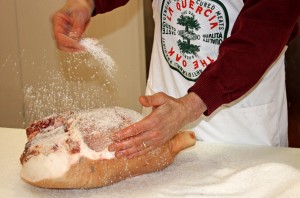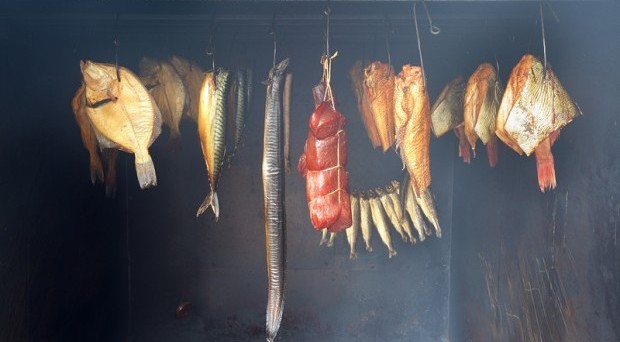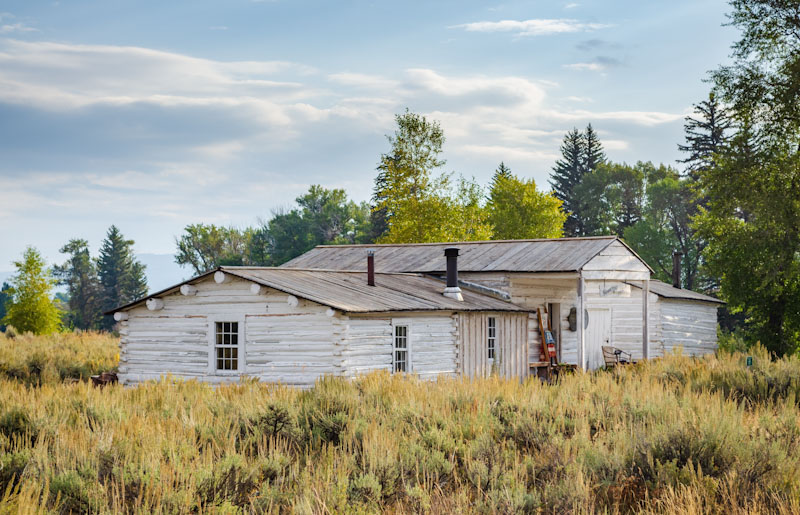In a SHTF event, chances are that you will not be able to rely on your fridge to preserve your food as usual.
People can get overtly reliant on fridges to store their food and this can be a problem.
If you don’t have access to a fridge anymore, what will you do? How will you preserve your meat for later use? People have been using other methods to preserve their food for centuries. This knowledge can come in real useful.
You can start by taking a look in your kitchen. Examine how much food you have and think how much of it would spoil without refrigeration.
Earn Your Food Independence NOW
Meat would be the first one to go once you lose electricity, but spoiling can be prevented using old-fashioned techniques. Methods such as smoking and curing are just two examples used for a long time, and are efficient when it comes to keeping meat from spoiling.
First, you need to decide on a place where you will store your meat. Ideally, you will want to do it in the coldest area available. Good examples are the attic, a storage shed, a shelter etc. Use a thermometer to check the temperature in each place and decide on the best one.
How to Cure Meat
Curing is a technique which basically involves preserving the meat in salt. This was one of the most common ways of keeping meat fresh in the days before refrigeration. Some still use it today, but now it is more about enhancing the flavor of the meat, not about preserving it.
Meat spoils because it is a good place for bacteria to thrive in. Bacteria need water, and there is a lot of water content in the meat, especially the muscle fibers. This is solved by introducing salt. It will expel a lot of the water from the meat, and creates an environment where bacteria cannot develop and multiply.

The sugar is necessary in order to counterbalance all of the salt, and will also give the meat a distinct flavor. If you like, other sweet products can be used such as honey or maple syrup.
You can also add your favorite herbs and spices if you want, they will also give your meat a unique aroma.
There is another ingredient which, ideally, should be included: sodium nitrite. It is particularly effective at fighting off botulism – a very bad bacterium which you do not want anywhere near your meat. At the same time, high levels of nitrite can also be toxic, and you need to take special care with this step.
There are two safe ways for you to add sodium nitrite.
- Using green leafy vegetables such as celery, spinach and lettuce. They all naturally contain sodium nitrite. You can add juice or extract and you will get the sodium nitrite you need.
- Adding pink salt. Also known as Prague Powder #1, this salt already contains a mixture of regular table salt and sodium nitrite in the appropriate composition.
Once you have the necessary ingredients, start cutting the meat into slabs. Pork is commonly used, but you can also use beef or fish. Take a slab and cover it heavily in the salt mixture. Do this with the rest of the meat. After this place it in jars or crocks for storage. Make sure that the meat slabs are tightly packed together.
Take them to your storage destination of choice. Make sure that the temperature is below 38 degrees Fahrenheit, but that it is well above freezing. 36 degrees Fahrenheit is ideal.
After about a month of storage, take the meat out. Take each slab and wrap it in paper or plastic. Either is fine as long as it is moisture-proof. This meat is now ready to be stored and consumed whenever you need it.
How to Brine Meat
The process described above is referred to as dry curing, but there is also a method for wet curing, also known as brining. This technique involves you keeping the meat submerged in a salty solution.
The steps are similar: the meat needs to be cut the same way and placed in jars or crocks. Wash the meat and sterilize the jars before you do.
Now you need to make the salt water. Adding about a pound of salt and half a cup of sugar to three quarts of water should do. Feel free to mix in other ingredients such as herbs and spices. Repeat this process until you have enough water for all of the jars. Fill each one up.
Make sure that the meat is completely submerged. If you are having problems, place a weight on top. Take the meat to your storage area.
Unlike dry curing, the meat will need your attention on a weekly basis. Each week you will have to take the meat out of the jars, stir the brine well and then place it back. After four weeks of repeating this process, your meat is ready. If you find the brine to be getting too thick, you will need to replace it with a fresh batch.
How to Smoke Meat
Smoke has the same effect as salt of keeping away bacteria from your meat. It also gives it a very tasty flavor which is why it is still used today.
If you know of a smokehouse near you, you can take it there, you will save time. If not, you can do the process yourself, but you will need a smoker. The good news is that they are available in all kinds of shapes and sizes, and use various fuels such as propane or charcoal. You can also modify grills or ovens to work as smokers, but the use of a regular smoker for this purpose is recommended.
This method is similar to grilling the meat and will generate a lot of smoke, so it needs to be done outdoors. However, grilling is a quick cooking process that uses high heat, while smoking takes much longer and uses indirect heat at low temperatures. The temperature should be anywhere between 150 and 225 degrees Fahrenheit.
This process is known as hard smoking and it is a way of cooking your meat in a way that will not require refrigeration. The end product will look similar to jerky.
Cold smoking is also available, and uses much lower temperatures below 100 degrees Fahrenheit. This method is only used for flavoring the meat rather than actually cooking it.
There you have it: three ways to prepare and preserve your meat for long periods of time. You should choose the one which is most accessible to you and meets your needs of survival.











Old Food | December 26, 2013
|
Our retreat site is located in a very rural area with excellent hunting, trapping plus fishing and while small game and fish can just be cooked up fresh, larger game such a deer and bear would need to be preserved. I’m glad this subject came up because though we’ve given it some thought, we never actually got off our duffs and acquired the necessary supplies and gear we would need to do this right. As cheap as salt is at the local bulk food store ($3.50/50 lbs); we haven’t stocked up near enough. Thanks! I’m on my way.
Richare | December 27, 2013
|
OLD FOOD
What food store do you get your salt for $3.50/50lb?
Rebecca | January 21, 2014
|
Hi , I would like to know where you buy bulk salt and esp that cheap. Thank you
Pingback:How to Preserve Meat for Survival | TheSurvivalPlaceBlog | December 26, 2013
|
Susan | December 26, 2013
|
I live in Florida, there is NO where I can store food without electricity that would have such cold temperatures. Any suggestions??
xxfireboy | December 27, 2013
|
Susan
I have the same problem. My solution for myself was to:
First
Learn how to dry meat using an electric food dehydrator, be able to learn how to dry meat of any kind and how to make jerky. All this was to
prepare me for drying outside which was the next step to accomplish
because there may not be any electric and I don’t have a generator.
Second
Learn how to build a dehydrator that works using the sun. A quire the
building plans and keep the plans safe until the time needed. I drew up my own plans from many that I saw on Youtube and from doing
searches. As long as there is plenty of sun and someone to guard the
dehydrator it’s all simple to build and dehydrator most anything.
Third
Until the electric is turned off there is one more item that is a must have to dehydrate and store food before troubled times, and that is a vacuum
sealer. I started with the minimum requirement (still learning, some can be costly) the Rival Vacuum Sealer from Walmart for $45 was and is my best money spent.
I have sealed a couple hundreds of pound of different foods and it is still
going strong.
I spent hours on Youtube(a place to learn) learning how to dehydrate, about dehydrator and about sealing and which sealer to buy.
I hope this helps.
Starling Black | December 27, 2013
|
I shot a caribou in Alaska and had no electricity. I boned out the meat with a knife and rubbed salt and allspice into the meat strip an inch to two inches thickness. I used way too much salt which made the meat very dry and hard. the only way to eat it was to boil it up and use as a soup meat. It tasted like salt, but never went bad.
Dennis | April 5, 2019
|
If you soak the meat in water for several Hours, it will draw the salt out of the meat and at the same time will Rehydrate the meat again, Hope this helps
An other day | August 18, 2019
|
Hello there Starling Black, Good Job with that caribou, plenty of meat, little secret about to Mach salt!!!
This is what you can do*** the old days they did what you have done, when was the time to eat that meat at night before, determining the amount of meat to be used for cooking and cover with cool or cold water over the the meat like 1/2-1 inch above the meat till the morning change the water and again cover the meat with water like above, by then the salt is out of the meat, rinse and do your magic of cooking recipe!
Now if you want to enhance the flavor to make the meat sweeter and not game then add milk one onion and one pepper cut in pieces like sautéed cutting live over night in refrigerator,
The next day discard milk peppers and onion rinse and do your cooking recipe!!!!
To your health and safety..
Paul McGinness | December 27, 2013
|
Consider fermentation for food storage. you can store meats and veggies for long periods and although cool temps are required-high 60’s to mid 70’s it is doable during the winter months in Florida.The are many books and instructions avaiable but I recomend the art of fermentation by Katz avaiable @Amazon.
Great Grey | December 28, 2013
|
Jerky is one way, and again there is the original way and the FDA way. Also look for how the local natives did things.
Great Grey | December 28, 2013
|
Also I advice you to avoid using MSG in any food, as it make you eat more than you would eat without it, and the last thing you need is to eat up your food, when you’re trying to make it last.
sierra star | December 27, 2013
|
When either salt curing meat or smoking the meat, what is the average shelf life of the product after curing?
tsimahei | May 19, 2016
|
6 month for it, frozen, if that long. If yo can, keep it in smoke and let it dry, but once the smoke is gone, you risk ham beetles feeding on it. Salt also draws moisture.
matt | December 27, 2013
|
I feel the canning meat should be listed as well.
Sophie | December 27, 2013
|
Susan: learn to dehydrate foods, even meats now, using a dehydrator. They come small starter type from Walmart. Or, you can buy a larger more consistent one like Excalibur or similar models. See dehydrate2store.com. However, you’ll have to look elsewhere for instructions on meat.
Dean Harris | December 27, 2013
|
From what I have read, cold smoking meats is a better long term solution for preservation. Something in the smoke at colder temps causes a different substance to accumulate on the surface of the meat causing it to last longer than smoking at higher temps. Anywhere from 100 to 110 degrees is the prefered temp for cold smoking. Just place your smoke/fire source around 10 feet away from the meat at an upward angle and the smoke should cool enough at that distance to cure it better. I am no expert and have never tried this but I have all the materials to build a cold smoker when needed. Do your own research, as I said this is just what i’ve read…
Mitchel | December 29, 2013
|
What temp’s are necessary for the brining process?
Thanks!
Pingback:How to Preserve Meat for Survival - BetterHomestead | February 13, 2014
|
Pingback:Survival Skills to Learn from the Indian Tribes | June 4, 2014
|
Pingback:Survival Skills to Learn from the Indian Tribes | TheSurvivalPlaceBlog | June 5, 2014
|
Manimal | June 11, 2014
|
They play up the idea of curing meat in case the power goes out and you don’t have access to refrigeration, but it seems to me if you need a 38* place to cure meat, you are going to need refrigeration.
Pingback:“SHTF” Survival – Wednesday 7.9.14 - 'Nox & Friends | July 9, 2014
|
Pingback:How to Preserve Meat for Survival « Patriot Net Daily | August 22, 2014
|
Pingback:Do It Yourself Preserve Meat By Dry Salting Or With A Salt Brine | December 23, 2014
|
Pingback:Survival Skills to Learn from the Indian Tribes - US Crisis PreppersUS Crisis Preppers | February 9, 2015
|
Pingback:A Prepper's Story: Headed To Alaska To Survive Off-grid | Survival skills, survival guns, survival guide | February 9, 2015
|
Pingback:A Prepper’s Story: Headed To Alaska To Survive Off-grid | The Prepper Dome | February 9, 2015
|
Pingback:DIY Projects: 15 Ideas For Using Cinder Blocks | Survival skills, survival guns, survival guide | May 26, 2015
|
Pingback:DIY Projects: 15 Ideas For Using Cinder Blocksdisasterdefense.us | disasterdefense.us | May 26, 2015
|
Pingback:DIY Projects: 15 Ideas For Using Cinder Blocks | The Prepper Dome | May 28, 2015
|
Pingback:DIY Food Dehydrator Ideas | Survival skills, survival guns, survival guide | July 16, 2015
|
Pingback:DIY Food Dehydrator Ideasdisasterdefense.usdisasterdefense.us | disasterdefense.us | July 16, 2015
|
Tommy Shumpert | July 17, 2015
|
We need this in the up coming years with what is going on in the United States
Pingback:DIY Food Dehydrator Ideas | TheSurvivalPlaceBlog | July 18, 2015
|
Pingback:DIY Food Dehydrator Ideas | July 23, 2015
|
Pingback:The Easy Way To Canning Meat Off Grid | Survival skills, survival guns, survival guide | September 14, 2015
|
Pingback:The Easy Way To Canning Meat Off Griddisasterdefense.us | disasterdefense.us | September 15, 2015
|
Pingback:Here’s What You Need To Know About Containersdisasterdefense.us | disasterdefense.us | October 12, 2015
|
Pingback:The Easy Way To Canning Meat Off Grid - US Crisis PreppersUS Crisis Preppers | October 26, 2015
|
Pingback:The Best Way To Stockpile Vegetables Off-Grid | Freedom Newz | November 11, 2015
|
Pingback:The Best Way To Stockpile Vegetables Off-Grid | The Prepper Dome | November 19, 2015
|
Pingback:The Easy Way To Canning Meat Off Grid | The Prepper Dome | November 26, 2015
|
Pingback:DIY Projects: 15 Ideas For Using Cinder Blocks - Prepper Ways | February 11, 2016
|
Pingback:» Back To Basics: How To Make Jerky For Survival - Prepper Ways | May 9, 2016
|
Pingback:5 Post-Apocalyptic Items worth More than Gold – usCrow The Elite Prepper Website for Survival | May 18, 2016
|
Pingback:» The Easy Way To Canning Meat Off Grid - Prepper Ways | May 23, 2016
|
Pingback:» The Best Way To Stockpile Vegetables Off-Grid - Prepper Ways | May 25, 2016
|
Pingback:SHTF : Cennejšie ako peniaze ? | Real Gear Military | May 25, 2016
|
Pingback:Prep Blog Review: Meal Ideas + How To Store Them | Survivopedia | June 11, 2016
|
Pingback:Prep Blog Review: Meal Ideas + How To Store Them | Prepper's Survival Homestead | June 11, 2016
|
Pingback:Prep Blog Review: Meal Ideas + How To Store Them | NewZSentinel | June 11, 2016
|
Pingback:Prep Blog Review: Meal Ideas + How To Store Them | | disasterdefense.us | June 11, 2016
|
Fox | June 26, 2016
|
Great article. I’d recommend looking at this new book: Extreme Survival Meat https://www.amazon.com/Extreme-Survival-Meat-Scavenging-Pemmican/dp/0989473716 It’s full of information on food procurement and processing.
David | July 13, 2016
|
I have a question as to what’s the difference between cooking a hambuger and making sausage? When I cook a hambuger and put it in the fridge I need to reheat it latter but with sausage or lunch meat nobody reheat that stuff so what is the differnce in the way their made? I have an excellent recipe for sausage I love but I don’t understand what part of it does this.
Matt | October 3, 2016
|
This article just assumes we can cure meat under mandated conditions by today’s standards. Clearly this is not sufficient for “survival” needs. An example of this is where it states “make sure that the temperature is below 38 degrees Fahrenheit, but that it is well above freezing. 36 degrees Fahrenheit is ideal.”
Well, unless you happen to have an underground cavern or cave in your backyard that maintains a temperature between approx 33-38 degrees F much of the year, this is a pretty useless piece of information. Clearly, if you are in any type of a “survival” type of situation, this is not a reasonable expectation.
The question that needs to be addressed in these kind of articles is “what if” 33-38 degrees is not possible?
I definitely know that people have salt cured meat for thousands of years without ideal temperature and humidity conditions. Clearly this poses greater risks. That is what these articles need to address. How is it “possible” to cure meat at less than ideal conditions? What are the risks? What is the probability of getting infected with botulism et al, is it 1/100 or 1/1,000,000? How can we reduce these risks?
Pingback:9 Tips To Smoking Meat Any Prepper Should Know | Survivopedia | November 13, 2017
|
jason Smith | January 8, 2018
|
do some research on how the Indians dried and stored their meat. beef jerky is a great route to go to dry and preserve your meat. just do the research and you will be fine.
https://www.facebook.com/Knife-Armory-334195753652650/
Pingback:DIY Projects: 15 Ideas For Using Cinder Blocks | Survivopedia | November 29, 2018
|
Larry Kestler | August 15, 2019
|
I was wondering, if the power goes out, for ever!! which may be the case the way the USA is going, I live in East Texas, hot and humid, can I take the frozen meat in the freezer, that has been vacuum sealed and submerse the packages in a natural tank or pond and will that keep the meat from spoiling and if so for how long?
CHRISTIE WAGNER | April 19, 2021
|
Larry Kestler: No, unfortunately. It will defrost and rot eventually. How long that takes depends on the food itself, and the outside temperature. Even if that didn’t happen, eventually the plastic would degrade and the vacuum seal would be broken. And fish nipping at the plastic could break it as well as stones underwater rubbing against the plastic.
CHRISTIE WAGNER | April 19, 2021
|
Terrific article by Bella Scotton. However, there should have been one clarification: regarding the “pink salt” she mentions. That pink salt is not to be confused with Himalayan Pink Salt. Himalayan Pink Salt contains no sodium nitrite, which chemical by the way is carcinogenic. The pink salt author Scotton refers to is CURING SALT which is sometimes synonymously referred to as “pink salt” because pink dye is put into it in order to avoid confusion with white table salt as well as to impart a pink color to the meat.